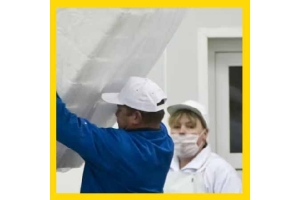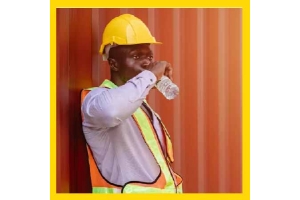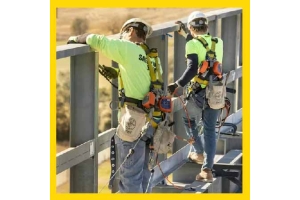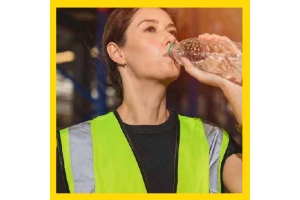Currency
March 25, 2018

In this article, Lauren O’Connor, from tool and equipment supplier Zoro, takes a closer look at how you should go about choosing the right equipment to protect your workforce.
Construction is a key industry, but it’s also one of the riskiest to work in. While many injuries are caused by slips and trips, falls, handling, and being struck by moving objects, there are a significant amount of health issues suffered because of exposure to hazardous substances.
According to HSE figures, there were 3,000 workers in construction that suffered breathing and lung problems in 2016/17, including occupational asthma, silicosis, and chronic obstructive pulmonary disease. There were also around 3,500 cancer deaths in the industry, a significant amount of which were caused by past exposure to asbestos and silica carcinogens.
As an employer, you have a legal duty of care to your staff to provide protection for any work that involved hazardous substances. That means you need to be able to identify the risks, put control measures in place, and make sure the right personal protective equipment (PPE) is available and used properly by all staff.
Here, I aim to help you understand the law around working with hazardous substances, and help you choose the right PPE to protect your workforce. Read on to find out more.
There are specialised laws for the control of hazardous substances in the workplace, and they’re put into action through the Control of Substances Hazardous to Health Regulations 2002 (COSHH). They dictate that employers must take steps to remove or reduce risk from these substances. As an employer in construction, it’s particularly important that you comply with the law, due to the heightened risk of exposure to your staff.
The COSHH Regulations apply to any substance that could be harmful to your employees’ health, and includes:
** Chemicals
** Products containing chemicals
** Fumes
** Dusts
** Vapours
** Mists
** Nanotechnology
** Gases
** Biological agents
The Regulations require you to carry out a COSHH risk assessment to identify the hazards and assess the level of risk (if you employ more than five people). This process involves evaluating your workplace and the tasks carried out by your staff and listing all the potential hazards that could be caused by harmful substances. The HSE has a comprehensive step by step guide to COSHH risk assessments, and you should definitely read it before you carry out your own.
The Regulations then set out a hierarchy that should be followed to control risk by removing it or reducing the chance of it occurring. Firstly, you should always take steps to prevent exposure at the source. This could mean finding ways to avoid using the hazardous substance altogether or swapping it for a less harmful one.
If you’re unable to prevent exposure, the next step is to introduce controls to ensure the level of risk is as low as is reasonably practicable. The HSE states that you must follow their Principles of Good Practice to ensure any measures are appropriate.

The Regulations dictate that, as an employer, it is your responsibility to pay for and provide protective equipment, as well as replace any items that suffer from a fault or wear and tear.
They also state that PPE should be used when other measures are not able to sufficiently control exposure to harmful substances. However, they’re still an important method of protection as they form the last line of defence for your staff. That’s why it’s very important that you take the time to identify the best type of PPE for the job and buy products that are fit for purpose.
There aren’t any explicit instructions when it comes to choosing PPE for your workforce, and instead the onus is on you to choose the most suitable type from a reliable manufacturer. There are a few types of PPE that you may want to consider, including:
** Respirators
** Protective gloves
** Eye protection
** Protective footwear
** Protective clothing
You’ll want to refer back to the findings from your COSHH risk assessment, as well as any manufacturer’s instructions attached to potentially harmful substances, as they will inform what kind of equipment you will need. If you’re finding it hard to source the right products, it’s often worth speaking to your supplier or trade association, who may be able to advise you.
Additionally, any products that you provide need to be suitable for the job, as you don’t want them creating a hazard themselves or increasing the level of risk. For instance, if work needs to be carried out in a confined space, then air-fed respirators with long cables may not be a good idea as they may get tangled. Your PPE should fit correctly and be comfortable enough to wear for the duration of the job, as well as being compatible with one another to ensure complete protection and ease of use.
Once you’ve sourced your PPE, you will need to make sure that your staff are using it correctly. If you’ve followed my advice and invested in equipment that fits properly and is comfortable, your workforce is much more likely to make use of it on the job.
You will need to provide training in how to use the equipment, so your workforce will be able to use it in the correct manner. You can back up your training programme with signs and posters that remind employees to make use of their PPE. It’s often a good idea to provide instructions on any notices, just in case your staff need to refer back to them for guidance.
The COSSH Regulations also require employers to carry out monitoring of control measures in some cases — see the HSE’s monitoring guidelines to find out when this is appropriate. It’s often necessary to keep track of whether your PPE is providing effective protection and to see if your staff are using it correctly, which can usually be tracked with close monitoring.
Construction is a key industry, but it’s also one of the riskiest to work in. While many injuries are caused by slips and trips, falls, handling, and being struck by moving objects, there are a significant amount of health issues suffered because of exposure to hazardous substances.
According to HSE figures, there were 3,000 workers in construction that suffered breathing and lung problems in 2016/17, including occupational asthma, silicosis, and chronic obstructive pulmonary disease. There were also around 3,500 cancer deaths in the industry, a significant amount of which were caused by past exposure to asbestos and silica carcinogens.
As an employer, you have a legal duty of care to your staff to provide protection for any work that involved hazardous substances. That means you need to be able to identify the risks, put control measures in place, and make sure the right personal protective equipment (PPE) is available and used properly by all staff.
Here, I aim to help you understand the law around working with hazardous substances, and help you choose the right PPE to protect your workforce. Read on to find out more.
What does the law say about working with hazardous substances?
There are specialised laws for the control of hazardous substances in the workplace, and they’re put into action through the Control of Substances Hazardous to Health Regulations 2002 (COSHH). They dictate that employers must take steps to remove or reduce risk from these substances. As an employer in construction, it’s particularly important that you comply with the law, due to the heightened risk of exposure to your staff.
The COSHH Regulations apply to any substance that could be harmful to your employees’ health, and includes:
** Chemicals
** Products containing chemicals
** Fumes
** Dusts
** Vapours
** Mists
** Nanotechnology
** Gases
** Biological agents
The Regulations require you to carry out a COSHH risk assessment to identify the hazards and assess the level of risk (if you employ more than five people). This process involves evaluating your workplace and the tasks carried out by your staff and listing all the potential hazards that could be caused by harmful substances. The HSE has a comprehensive step by step guide to COSHH risk assessments, and you should definitely read it before you carry out your own.
The Regulations then set out a hierarchy that should be followed to control risk by removing it or reducing the chance of it occurring. Firstly, you should always take steps to prevent exposure at the source. This could mean finding ways to avoid using the hazardous substance altogether or swapping it for a less harmful one.
If you’re unable to prevent exposure, the next step is to introduce controls to ensure the level of risk is as low as is reasonably practicable. The HSE states that you must follow their Principles of Good Practice to ensure any measures are appropriate.

What do I need to think about when choosing PPE?
The Regulations dictate that, as an employer, it is your responsibility to pay for and provide protective equipment, as well as replace any items that suffer from a fault or wear and tear.
They also state that PPE should be used when other measures are not able to sufficiently control exposure to harmful substances. However, they’re still an important method of protection as they form the last line of defence for your staff. That’s why it’s very important that you take the time to identify the best type of PPE for the job and buy products that are fit for purpose.
There aren’t any explicit instructions when it comes to choosing PPE for your workforce, and instead the onus is on you to choose the most suitable type from a reliable manufacturer. There are a few types of PPE that you may want to consider, including:
** Respirators
** Protective gloves
** Eye protection
** Protective footwear
** Protective clothing
You’ll want to refer back to the findings from your COSHH risk assessment, as well as any manufacturer’s instructions attached to potentially harmful substances, as they will inform what kind of equipment you will need. If you’re finding it hard to source the right products, it’s often worth speaking to your supplier or trade association, who may be able to advise you.
Additionally, any products that you provide need to be suitable for the job, as you don’t want them creating a hazard themselves or increasing the level of risk. For instance, if work needs to be carried out in a confined space, then air-fed respirators with long cables may not be a good idea as they may get tangled. Your PPE should fit correctly and be comfortable enough to wear for the duration of the job, as well as being compatible with one another to ensure complete protection and ease of use.
How do I make sure COSHH PPE is used correctly?
Once you’ve sourced your PPE, you will need to make sure that your staff are using it correctly. If you’ve followed my advice and invested in equipment that fits properly and is comfortable, your workforce is much more likely to make use of it on the job.
You will need to provide training in how to use the equipment, so your workforce will be able to use it in the correct manner. You can back up your training programme with signs and posters that remind employees to make use of their PPE. It’s often a good idea to provide instructions on any notices, just in case your staff need to refer back to them for guidance.
The COSSH Regulations also require employers to carry out monitoring of control measures in some cases — see the HSE’s monitoring guidelines to find out when this is appropriate. It’s often necessary to keep track of whether your PPE is providing effective protection and to see if your staff are using it correctly, which can usually be tracked with close monitoring.









